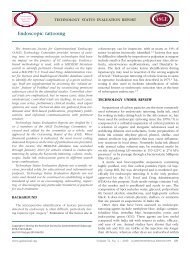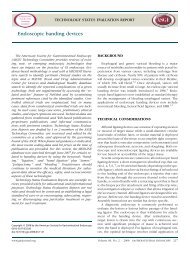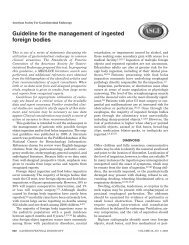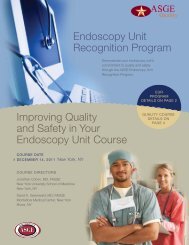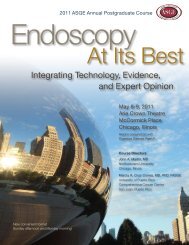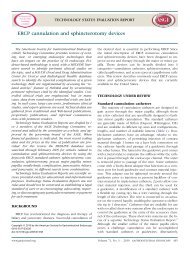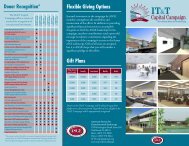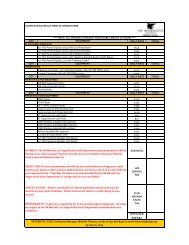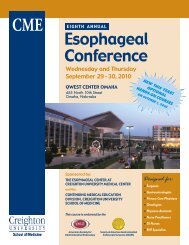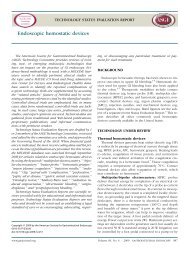Ambulatory Surgery Centers â A Positive Trend in Health Care
Ambulatory Surgery Centers â A Positive Trend in Health Care
Ambulatory Surgery Centers â A Positive Trend in Health Care
You also want an ePaper? Increase the reach of your titles
YUMPU automatically turns print PDFs into web optimized ePapers that Google loves.
AMBULATORY SURGERY CENTERS: A POSITIVE TREND IN HEALTH CARE • <strong>Ambulatory</strong> <strong>Surgery</strong> <strong>Centers</strong>A P O S I T I V E T R E N D I N H E A L T H C A R E<strong>Ambulatory</strong> surgery centers (ASCs) are health care facilities which offer patients the opportunity to have selected surgical and proceduralservices performed outside the hospital sett<strong>in</strong>g. S<strong>in</strong>ce their <strong>in</strong>ception more than three decades ago, ASCs have demonstrated an exceptionalability to improve quality and customer service while simultaneously reduc<strong>in</strong>g costs. At a time when most developments <strong>in</strong> health careservices and technology typically come with a higher price tag, ASCs stand out as an exception to the rule.A Progressive Model for Surgical ServicesAs our nation struggles with how to improve a troubled healthcare system, the experience of ASCs is a rare example of asuccessful transformation <strong>in</strong> health care delivery.Thirty years ago, virtually all surgery was performed <strong>in</strong> hospitals.Waits of weeks or months for an appo<strong>in</strong>tment were not uncommon,and patients typically spent several days <strong>in</strong> the hospital andseveral weeks out of work <strong>in</strong> recovery. In many countries,surgery is still like this today, but not <strong>in</strong> the United States.Physicians have led the development of ASCs. The first facilitywas opened <strong>in</strong> 1970 by two physicians who saw an opportunityto establish a high-quality, cost-effective alternative to <strong>in</strong>patienthospital care for surgical services. Faced with frustrations likeschedul<strong>in</strong>g delays, limited operat<strong>in</strong>g room availability, andchallenges <strong>in</strong> obta<strong>in</strong><strong>in</strong>g new equipment due to hospital budgetsand policies, physicians were look<strong>in</strong>g for a better way - anddeveloped it <strong>in</strong> ASCs.Physicians cont<strong>in</strong>ue to provide the impetus for the developmentof new ASCs. By operat<strong>in</strong>g <strong>in</strong> ASCs <strong>in</strong>stead of hospitals,physicians ga<strong>in</strong> the opportunity to have more direct controlover their surgical practices. 1 In the ASC sett<strong>in</strong>g, physiciansare able to schedule procedures more conveniently, assembleteams of specially-tra<strong>in</strong>ed and highly skilled staff, ensure theequipment and supplies be<strong>in</strong>g used are best suited to theirtechnique, and design facilities tailored to their specialties.Simply stated, physicians are striv<strong>in</strong>g for, and have found <strong>in</strong>ASCs, the professional autonomy over their work environmentand over the quality of care that has not been available to them<strong>in</strong> hospitals. These benefits expla<strong>in</strong> why physicians who do nothave ownership <strong>in</strong>terest <strong>in</strong> ASCs (and therefore do not benefitf<strong>in</strong>ancially from perform<strong>in</strong>g procedures <strong>in</strong> an ASC) choose towork <strong>in</strong> ASCs <strong>in</strong> such high numbers.note is how many ASCs are jo<strong>in</strong>tly owned by local hospitalsthat now <strong>in</strong>creas<strong>in</strong>gly recognize and embrace the value of theASC model. Accord<strong>in</strong>g to the most recent data available,hospitals have ownership <strong>in</strong>terest <strong>in</strong> 21% of all ASCs; 3%are owned entirely by hospitals. 2Copyright © 2002 SMG Market<strong>in</strong>g Group IncGiven the history of their <strong>in</strong>volvement with mak<strong>in</strong>g ASCs areality, it is not surpris<strong>in</strong>g physicians cont<strong>in</strong>ue to have ownership<strong>in</strong> virtually all (90%) ASCs. But what is more <strong>in</strong>terest<strong>in</strong>g toCopyright © 2002 SMG Market<strong>in</strong>g Group Inc
AMBULATORY SURGERY CENTERS: A POSITIVE TREND IN HEALTH CARE • 2004 ASC Salary and Benefits Survey, Federated<strong>Ambulatory</strong> <strong>Surgery</strong> Association, 2004.ASCs ALLOW PHYSICIANS TO WORK EFFICIENTLYA recent analysis exam<strong>in</strong>ed the impact of the ag<strong>in</strong>gpopulation on the demand for surgical procedures andattendant need for surgical subspecialists. This studyconcluded that the ag<strong>in</strong>g population would be a majorforce <strong>in</strong> driv<strong>in</strong>g significant growth <strong>in</strong> the demand forsurgical services. The forecasted growth <strong>in</strong> work by the year2020 varied from 14 percent to 47 percent, depend<strong>in</strong>g onspecialty. 3 Meet<strong>in</strong>g these surgical needs will be a challenge.Solutions <strong>in</strong>clude <strong>in</strong>creas<strong>in</strong>g the number of surgicalresidency positions, <strong>in</strong>creas<strong>in</strong>g the workloads of surgeons <strong>in</strong>the workforce, and improv<strong>in</strong>g the efficiency of surgeons.Utiliz<strong>in</strong>g sett<strong>in</strong>gs that allow physicians to practice efficientlywill help mitigate the impact of the ag<strong>in</strong>g population onthe anticipated shortage <strong>in</strong> the surgery workforce. ASCsoffer physicians the ability to work more efficiently and aretherefore uniquely positioned to play an important role <strong>in</strong>manag<strong>in</strong>g the <strong>in</strong>creased need for surgical services as it arises<strong>in</strong> the years ahead.Etzioni DA, Liu JH, Maggard MA, Ko CY. The ag<strong>in</strong>g population and its impact on the surgery workforce. Ann Surg. 2003 Aug;238(2):170-7.
AMBULATORY SURGERY CENTERS: A POSITIVE TREND IN HEALTH CARE • SPECIFIC FEDERAL REQUIREMENTS GOVERNING ASCSIn order to participate <strong>in</strong> the Medicare program, ASCs arerequired to meet certa<strong>in</strong> conditions set by the federal governmentdesigned to ensure the facility is operated <strong>in</strong> a manner thatensures the safety of patients and the quality of services. Someof these requirements are highlighted <strong>in</strong> more detail below.ASCs are required to ma<strong>in</strong>ta<strong>in</strong> complete, comprehensive andaccurate medical records. The content of these records must<strong>in</strong>clude a medical history and physical exam<strong>in</strong>ation relevantto the reason for the surgery and the type of anesthesia planned.In addition, a physician must exam<strong>in</strong>e the patient immediatelybefore surgery to evaluate the risk of anesthesia and the procedureto be performed. Prior to discharge each patient must beevaluated by a physician for proper anesthesia recovery.CMS requires ASCs to ensure patients do not acquire<strong>in</strong>fections dur<strong>in</strong>g their care at these facilities. ASCsmust establish a program for identify<strong>in</strong>g and prevent<strong>in</strong>g<strong>in</strong>fections, ma<strong>in</strong>ta<strong>in</strong><strong>in</strong>g a sanitary environment, andreport<strong>in</strong>g outcomes to appropriate authorities. The programmust be one of active surveillance and <strong>in</strong>clude specificprocedures for prevention, early detection, control, and<strong>in</strong>vestigation of <strong>in</strong>fectious and communicable diseases <strong>in</strong>accordance with the recommendations of the <strong>Centers</strong> forDisease Control. In fact, ASCs have historically had verylow <strong>in</strong>fection rates. 10A registered nurse tra<strong>in</strong>ed <strong>in</strong> the use of emergencyequipment and <strong>in</strong> cardiopulmonary resuscitation mustbe available whenever a patient is <strong>in</strong> the ASC. To furtherprotect patient safety, ASCs are also required to have aneffective means of transferr<strong>in</strong>g patients to a hospital foradditional care <strong>in</strong> the event an emergency occurs. Writtenguidel<strong>in</strong>es outl<strong>in</strong><strong>in</strong>g arrangements for ambulance servicesand transfer of medical <strong>in</strong>formation are mandatory. An ASCmust have a written transfer agreement with a local hospital,or all physicians perform<strong>in</strong>g surgery <strong>in</strong> the ASC must haveadmitt<strong>in</strong>g privileges at the designated hospital. Althoughthese safeguards are <strong>in</strong> place, hospital admissions as a resultof complications follow<strong>in</strong>g ambulatory surgery are rare. 9,11Cont<strong>in</strong>uous quality improvement is an important meansof assur<strong>in</strong>g patients are receiv<strong>in</strong>g the best care possible.ASCs are required to implement and monitor policiesthat ensure the facility provides quality health care <strong>in</strong> asafe environment. An ASC, with the active participationof the medical staff, is required to conduct an ongo<strong>in</strong>g,comprehensive assessment of the quality of care provided.The excellent outcomes associated with ambulatory surgeryreflect the commitment that the ASC <strong>in</strong>dustry has madeto quality and safety. One of the many reasons that ASCscont<strong>in</strong>ue to be so successful with patients, physicians and<strong>in</strong>surers is their keen focus on ensur<strong>in</strong>g the quality of theservices provided.Medicare Requirements for ASCs and HospitalsAre The Same Where Services are ComparableRequired Standards ASC HospitalCompliance with state licensure law r rGovern<strong>in</strong>g body r rSurgical services r rEvaluation of quality r rEnvironment r rMedical staff r rNurs<strong>in</strong>g services r rMedical records r rPharmaceutical services r rLaboratory services r rRadiologic services r rSource: 42 CFR 416, 42 CFR 482THE ASC INDUSTRY IS COMMITTEDTO REPORTING QUALITY MEASURESA fundamental change <strong>in</strong> the way the government assuresthe quality of health care services is well underway. TheDepartment of <strong>Health</strong> and Human Services has launchedits Quality Initiative to assure quality health care throughaccountability and public disclosure.The ASC <strong>in</strong>dustry is excited to have the opportunity to makeits excellent outcomes more widely known to the publicthrough this <strong>in</strong>itiative. Leaders from the ASC <strong>in</strong>dustry, alongwith associations and related organizations with a focus onhealth care quality and safety, have come together <strong>in</strong> acollaborative effort to identify specific measures forquality appropriate to ASCs. This group, the ASC QualityCollaboration, strongly endorses the vision that measures ofquality which are appropriate to ASCs should be congruentwith measures utilized for other outpatient surgery sett<strong>in</strong>gs.The cont<strong>in</strong>ued development of these measures will <strong>in</strong>volvea number of different stakeholders <strong>in</strong>clud<strong>in</strong>g ASC cl<strong>in</strong>icaland adm<strong>in</strong>istrative leaders, health policy researchers, CMSand other key federal and state governmental agencies. Thegroup will also work with the National Quality Forum toachieve consensus on the proposed quality measures.PATIENT SATISFACTIONPatient satisfaction is a hallmark of the ASC <strong>in</strong>dustry. This year,more than eight million Americans will undergo surgery <strong>in</strong> an ASC.Virtually all of those patients will return home the same day andwill resume most normal activities with<strong>in</strong> a matter of days. Talkto these patients and you will hear how overwhelm<strong>in</strong>gly satisfiedthey are with their ASC experience. Recent surveys show averagepatient satisfaction levels <strong>in</strong> ASCs exceed<strong>in</strong>g 90 percent. 4 Safe andhigh quality services, ease of schedul<strong>in</strong>g, greater personal attentionand lower costs are among the ma<strong>in</strong> reasons cited for the grow<strong>in</strong>gpopularity of ASCs as a place for hav<strong>in</strong>g surgery.
AMBULATORY SURGERY CENTERS: A POSITIVE TREND IN HEALTH CARE • ASCs Provide care at significant cost sav<strong>in</strong>gsNot only are ASCs focused on ensur<strong>in</strong>g patients have thebest surgical experience possible, the care they provide isalso more affordable. One of the reasons ASCs have beenso successful is they offer valuable surgical and proceduralservices at a lower cost when compared to hospital chargesfor the same services. Beg<strong>in</strong>n<strong>in</strong>g <strong>in</strong> 2007, Medicarepayments to ASCs will be lower than or equal to Medicarepayments to HOPDs for comparable services for 100percent of procedures. 12In addition, patients typically pay less co<strong>in</strong>surance forprocedures performed <strong>in</strong> the ASC than for comparableprocedures <strong>in</strong> the hospital sett<strong>in</strong>g. For example, a Medicarebeneficiary could pay as much as $496 <strong>in</strong> co<strong>in</strong>surance fora cataract extraction procedure performed <strong>in</strong> a HOPD,whereas that same beneficiary’s copayment <strong>in</strong> the ASCwould be only $195; a Medicare beneficiary could pay asmuch as $186 <strong>in</strong> co<strong>in</strong>surance for a colonoscopy performed<strong>in</strong> a HOPD, whereas that same beneficiary’s copayment forthe same procedure performed <strong>in</strong> an ASC would be only$89. By hav<strong>in</strong>g surgery <strong>in</strong> the ASC the patient may save asmuch as 61%, or more than $300, compared to their out-ofpocketco<strong>in</strong>surance for the same procedure <strong>in</strong> the hospital.Without the emergence of ASCs as an option for care, healthcare expenditures would have been billions of dollars higherover the past three decades. Studies have shown the Medicareprogram would pay approximately $464 million more peryear if all procedures performed <strong>in</strong> an ASC were <strong>in</strong>steadfurnished at a hospital. 13 Private <strong>in</strong>surance companies tendto save similarly, which means employers also <strong>in</strong>cur lowerhealth care costs by utiliz<strong>in</strong>g ASC services. Employers and<strong>in</strong>surers, particularly managed care entities, are driv<strong>in</strong>g ASCgrowth <strong>in</strong> many areas, because they recognize ASCs are ableto deliver consistent, high quality outcomes at a significantsav<strong>in</strong>gs. As the number of surgical procedures performed <strong>in</strong>ASCs grows, the Medicare program may realize even greatersav<strong>in</strong>gs - and of course Medicare beneficiaries will realizeadditional out-of-pocket sav<strong>in</strong>gs as well. 13MedPAC, Report to the Congress: Medicare Payment Policy, March 2004.THe ASC <strong>in</strong>dustry supports disclosure of pric<strong>in</strong>g <strong>in</strong>formationIt is the general practice of ASCs to make pric<strong>in</strong>g<strong>in</strong>formation available to the patient <strong>in</strong> advance of surgery.The <strong>in</strong>dustry is eager to make price transparency a reality,not only for Medicare beneficiaries, but for all patients. Tooffer maximum benefit to the consumer, these disclosuresshould outl<strong>in</strong>e the total price of the planned surgicalprocedure and the specific portion for which the patientwould be responsible. This will empower health careconsumers as they evaluate and compare costs for the sameservice amongst various health care providers.
Technological advancement has allowed a grow<strong>in</strong>g rangeof procedures to be performed safely on an outpatientbasis. Faster act<strong>in</strong>g and more effective anesthetics and less<strong>in</strong>vasive techniques, such as arthroscopy, have driven thisoutpatient migration. Procedures that only a few yearsago required major <strong>in</strong>cisions, long-act<strong>in</strong>g anesthetics andextended convalescence can now be performed throughclosed techniques utiliz<strong>in</strong>g short-act<strong>in</strong>g anesthetics, and withm<strong>in</strong>imal recovery time. As medical <strong>in</strong>novation cont<strong>in</strong>uesto advance, more and more procedures will be able to beperformed safely <strong>in</strong> the outpatient sett<strong>in</strong>g.AMBULATORY SURGERY CENTERS: A POSITIVE TREND IN HEALTH CARE • ASCs Improve Patient Choice, Demand for ASCs GrowsThe number of ASCs cont<strong>in</strong>ues to grow <strong>in</strong> response todemand from the key participants <strong>in</strong> surgical care – patients,physicians and <strong>in</strong>surers. This demand has been madepossible by technology, but has been driven by high levels ofpatient satisfaction, efficient physician practice, high levelsof quality and the cost sav<strong>in</strong>gs that have benefited all. Thenumber of Medicare certified ASCs has grown from 2786 <strong>in</strong>1999 to 4506 <strong>in</strong> 2005, with an average annual growth rateof 8.3%. 14Further impetus to future ASC growth has been givenby MedPAC, which has recommended that the CMS listof approved ASC procedures be expanded. This wouldASCS WILL CONTINUE TO LEADINNOVATION IN OUTPATIENTSURGICAL CAREAs leaders of the revolution <strong>in</strong> surgical care who led to the establishmentof affordable and safe outpatient surgery, the ASC<strong>in</strong>dustry has shown itself to be ahead of the curve <strong>in</strong> identify<strong>in</strong>gpromis<strong>in</strong>g avenues for improv<strong>in</strong>g the delivery of health care.With a solid track record of performance <strong>in</strong> stakeholder satisfaction,safety, quality and cost management, the ASC <strong>in</strong>dustryis already embrac<strong>in</strong>g the changes that will allow it to cont<strong>in</strong>ueto play a lead<strong>in</strong>g role <strong>in</strong> rais<strong>in</strong>g the standards of performance <strong>in</strong>the delivery of outpatient surgical services.As always, the ASC <strong>in</strong>dustry welcomes any opportunity toclarify the services it offers, the regulations and standardsgovern<strong>in</strong>g its operations, and the ways <strong>in</strong> which it ensures safe,high-quality care for patients.MedPAC, Data Book, June 2006.allow a broader range of choice for patients and surgeons.Specifically, MedPAC has recommended the proceduresapproved for the ASC sett<strong>in</strong>g be revised so that ASCscan receive payment for any surgical procedure, with theexception of those surgeries requir<strong>in</strong>g an overnight stay orwhich pose a significant safety risk when furnished <strong>in</strong> anASC.8 Adoption of these recommendations would allowMedicare beneficiaries to access an extended range of surgicalservices – a range of surgical services which is alreadyavailable to patients with private <strong>in</strong>surance. 15POLICY CONSIDERATIONSGiven the cont<strong>in</strong>ued fiscal challenges posed by adm<strong>in</strong>ister<strong>in</strong>ghealth care programs, policy makers and regulators shouldcont<strong>in</strong>ue to focus on foster<strong>in</strong>g <strong>in</strong>novative methods of healthcare delivery that offer safe, high-quality care so progressivechanges <strong>in</strong> the nation’s health care system can be implemented.Support should be reserved for those policies that promotethe utilization of sites of service provid<strong>in</strong>g more affordablecare while ma<strong>in</strong>ta<strong>in</strong><strong>in</strong>g high quality and safety standards. Inlight of the many benefits ASCs have brought to the nation’shealth care system, it will be important for future paymentand coverage policies to cont<strong>in</strong>ue to strengthen access to andutilization of ASCs.
ENDNOTESAMBULATORY SURGERY CENTERS: A POSITIVE TREND IN HEALTH CARE • 71 “<strong>Ambulatory</strong> <strong>Surgery</strong> <strong>Centers</strong>.” Encyclopedia of <strong>Surgery</strong>. Ed. Anthony J. Senagore. Thomson Gale, 2004.2 2004 ASC Salary and Benefits Survey, Federated <strong>Ambulatory</strong> <strong>Surgery</strong> Association, 2004.3 Etzioni DA, Liu JH, Maggard MA, Ko CY. The ag<strong>in</strong>g population and its impact on the surgery workforce. Ann Surg.2003 Aug;238(2):170-7.4 Press Ganey Associates, 2004.5 <strong>Centers</strong> for Medicare and Medicaid Services ASC Website, http://www.cms.hhs.gov/center/asc.asp6 70 Fed. Reg. pp.68916-68964, November 10, 2005.7 42 C.F.R. §4828 42 C.F.R. §4169 Fleisher LA, Pasternak LR, Herbert R, Anderson GF. Inpatient hospital admission and death after outpatient surgery <strong>in</strong> elderlypatients: importance of patient and system characteristics and location of care. Arch Surg. 2004 Jan;139(1):67-72.10 FASA, FASA Outcomes Monitor<strong>in</strong>g Project, 4th Quarter 200511 Natof HE. Complications associated with ambulatory surgery. JAMA. 1980 Sep 5;244(10):1116-8.12 Deficit Reduction Act of 2005.13 MedPAC, Report to the Congress: Medicare Payment Policy, March 2004.14 MedPAC, Data Book, June 2006.15 Thomson Medstat, MarketScan® Outpatient Claims Data, 2005.This report was prepared by the ASC Coalition and is further supported by the follow<strong>in</strong>g organizations:Alabama <strong>Ambulatory</strong> <strong>Surgery</strong> AssociationAmerican Association of <strong>Ambulatory</strong> <strong>Surgery</strong> <strong>Centers</strong>AmSurgArizona <strong>Ambulatory</strong> <strong>Surgery</strong> Center AssociationArkansas <strong>Ambulatory</strong> <strong>Surgery</strong> AssociationCalifornia <strong>Ambulatory</strong> <strong>Surgery</strong> AssociationColorado <strong>Ambulatory</strong> <strong>Surgery</strong> Center AssociationFASAFlorida Society of <strong>Ambulatory</strong> Surgical <strong>Centers</strong>Foundation for <strong>Ambulatory</strong> <strong>Surgery</strong> <strong>in</strong> AmericaFreestand<strong>in</strong>g <strong>Ambulatory</strong> <strong>Surgery</strong> Center Association of TennesseeGeorgia Society of <strong>Ambulatory</strong> <strong>Surgery</strong> <strong>Centers</strong><strong>Health</strong>mark Industries Co<strong>Health</strong>SouthIdaho <strong>Ambulatory</strong> <strong>Surgery</strong> Center AssociationIll<strong>in</strong>ois Freestand<strong>in</strong>g <strong>Surgery</strong> Center AssociationIndiana Federation of <strong>Ambulatory</strong> Surgical <strong>Centers</strong>Kansas Association of <strong>Ambulatory</strong> <strong>Surgery</strong> <strong>Centers</strong>
Kentucky <strong>Ambulatory</strong> <strong>Surgery</strong> Center AssociationMa<strong>in</strong>e <strong>Ambulatory</strong> <strong>Surgery</strong> Center CoalitionMaryland <strong>Ambulatory</strong> Surgical AssociationMississippi <strong>Ambulatory</strong> <strong>Surgery</strong> AssociationMissouri <strong>Ambulatory</strong> <strong>Surgery</strong> Center AssociationNational Surgical <strong>Care</strong>Nevada <strong>Ambulatory</strong> <strong>Surgery</strong> AssociationNew Hampshire <strong>Ambulatory</strong> Surgical AssociationNovaMedOhio Association of <strong>Ambulatory</strong> <strong>Surgery</strong> <strong>Centers</strong>Pennsylvania <strong>Ambulatory</strong> <strong>Surgery</strong> AssociationSouth Carol<strong>in</strong>a <strong>Ambulatory</strong> <strong>Surgery</strong> Center AssociationSouth Dakota Association of Specialty <strong>Care</strong> ProvidersSymbion <strong>Health</strong>careTexas <strong>Ambulatory</strong> <strong>Surgery</strong> Center SocietyUnited Surgical Partners InternationalUtah <strong>Ambulatory</strong> <strong>Surgery</strong> Center AssociationWash<strong>in</strong>gton <strong>Ambulatory</strong> <strong>Surgery</strong> Center AssociationProvided to You Courtesy ofThe American Society for Gastro<strong>in</strong>test<strong>in</strong>al EndoscopyFor <strong>in</strong>formation, call Randy Fenn<strong>in</strong>ger at 202.833.0007AMBULATORY SURGERY CENTERS: A POSITIVE TREND IN HEALTH CARE • 8



